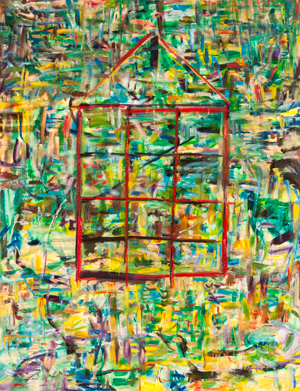About this series
Inspired by the curous story by J.R.R.Tolkein (Lord of the Rings Tolkein) titled "Leaf by Niggle". You can read the PDF here.
This is also titled the Losing and Finding group.
"..."Niggle woke up to find that his blinds were drawn, and his little cell was full of sunshine. He got up, and found..."
Many of these utilize a grid against the ground creating a focus within each cell. That is the 'finding'. The 'losing' occurs when what I discovered in the painting process, begins to be lost/ only to uncover something new yet again.
from Leaf by Niggle:
"Niggle pushed open the gate, jumped on the bicycle, and went bowling downhill in the spring sunshine. Before long he found that the path on which he had started had disappeared, and the bicycle was rolling along over a marvellous turf. It was green and close; and yet he could see every blade distinctly. He seemed to remember having seen or dreamed of that sweep of grass somewhere or other.
The curves of the land were familiar somehow. Yes: the ground was becoming level, as it should, and now, of course, it was beginning to rise again. A great green shadow came between him and the sun. Niggle looked up, and fell off his bicycle.
Before him stood the Tree, his Tree, finished. If you could say that of a Tree that was alive, its leaves opening, its branches growing and bending in the wind that Niggle had so often felt or guessed, and had so often failed to catch. He gazed at the Tree, and slowly he lifted his arms and opened them wide.
"It's a gift!" he said. He was referring to his art, and also to the result; but-he was using the word quite literally.
He went on looking at the Tree. All the leaves he had ever laboured at were there, as he had imagined them rather than as he had made them; and there were others that had only budded in his mind, and many that might have budded, if only he had had time. Nothing was written on them, they were just exquisite leaves, yet they were dated as clear as a calendar. Some of the most beautiful-and the most characteristic, the most perfect examples of the Niggle style-were seen to have been produced in collaboration with Mr. Parish: there was no other way of putting it.
The birds were building in the Tree. Astonishing birds: how they sang! They were mating, hatching, growing wings, and flying away singing into the Forest, even while he looked at them.
For now he saw that the Forest was there too, opening out on either side, and marching away into the distance. The Mountains were glimmering far away. After a time Niggle turned towards the Forest. Not because he was 'tired of the Tree, but he seemed to have got it all clear in his mind now, and was aware of it, and of its growth, even when he was not looking at it.
As he walked away, he discovered an odd thing: the Forest, of course, was a distant Forest, yes he could approach it, even enter it, without its losing that particular charm. He had never before been able to walk into the distance without turning it into mere surroundings. It really added a considerable attraction to walking in the country, because, as you walked, new distances opened out; so that you now had doubled, treble, and quadruple distances, doubly, trebly, and quadruply enchanting. You could go on and on, and have a whole country in a garden, or in a picture (if you preferred to call it that). You could go on and on, but not perhaps for ever. There were the Mountains in the background. They did get nearer, very slowly. They did not seem to belong to the picture, or only as a link to something else, a glimpse through the trees of something different, a further stage: another picture..." |
| |
..."Niggle woke up to find that his blinds were drawn, and his little cell was full of sunshine. He got up, and found... |
|
|
|

